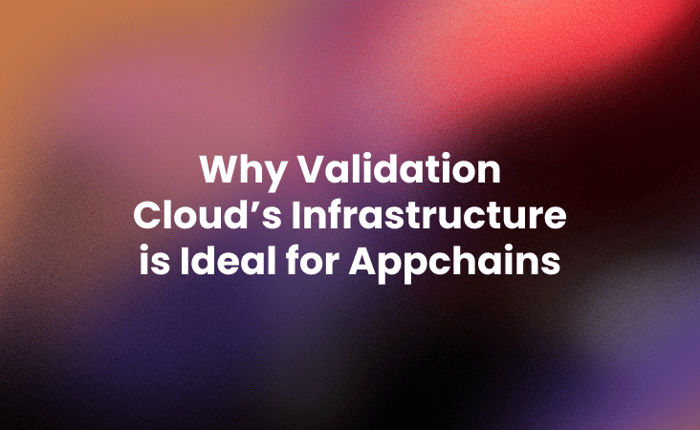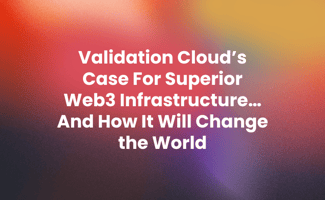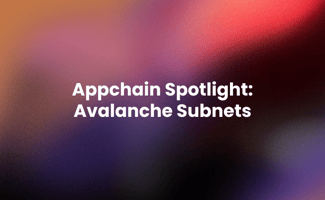As an enterprise-grade Web3 infrastructure company, Validation Cloud sits at the intersection of...
Why Validation Cloud’s Infrastructure is Ideal for Appchains

In the first part of our Appchain Series, we discussed the emergence of appchains and identified them as a major catalyst for enterprise adoption of Web3. We explained that appchains represent a hybrid of public and private blockchains, channeling the best of each in a single paradigm. Specifically, the composability, compliance, and confidentiality (i.e., the 3C’s) of appchains provide the ideal blockspace for Web2 platforms eager to adopt Web3 products and/or capabilities.
With this post, we’d like to further the discussion of appchains by addressing their setup, implementation, and maintenance; with a specific lens toward the infrastructure implications (and complexities) of running appchains. We will also discuss why Validation Cloud’s platform is uniquely positioned to support enterprises’ adoption of appchains.
How running appchains differs from running private and public blockchains
Validation Cloud has been working closely with a number of networks that have either launched or intend to launch appchains in the near future. Through this work, we’ve developed unique insights into the infrastructure operationalization of appchains, where blockspace theory meets commercial applications. Our quick synopsis: appchains require customizable and elastic infrastructure, which few of the legacy infrastructure providers are architected to deliver. Before diving into why architecture matters, let’s cover the key differences between running appchains vs. private/public blockchains.
Creating a new blockchain requires building and deploying all of the infrastructure and consensus mechanisms from scratch. As this entails a huge development lift, many chains have opted to fork public blockchain code or use modular frameworks with built-in consensus and peering capabilities — while this reduces development costs, it doesn’t eliminate them. Many engineers are still needed to maintain the code, manage releases, and test the deployments. In aggregate, an ecosystem will spend $10s of millions annually just to support the bare minimum requirements for infrastructure and staffing. Imposing this massive financial and technical burden on users is an existential problem, stunting network adoption and application scalability.
Aside from the development cost, public foundations spend time and resources recruiting validator operators and managing the relationship. In the case of private blockchains, enterprises need to deploy and manage the validator infrastructure themselves which adds to the cost of creating the chain.
Appchains have been created to solve those issues and reduce the cost of running a blockchain. Typically, appchains leverage the existing infrastructure and consensus mechanisms of the public chain, allowing developers to focus on building their applications, without needing to manage the infrastructure themselves.
In order to scale appchain ecosystems, Web3 providers must be able to elastically and dynamically add new validators. Just as horizontal scaling is crucial to scale Web2 systems, it’s fundamental for dynamically commissioning new validators for Web3 appchains.
Validation Cloud is uniquely positioned to successfully deploy, manage, and scale appchains. We have architected our infrastructure to be highly elastic across our global regions of operation. As the load of the appchain increases or new appchains emerge, we can dynamically add validators to different regions of the world, and through our Node API, provide multi-region access to the appchain.
Infrastructure Implications — Architecture Matters
The idiosyncrasies of running appchains have genuine implications for Web3 infrastructure providers, all of which were architected for monolithic vs. the dynamic infrastructure provisioning developed by Validation Cloud. To that end, we believe monolithic infrastructure provisioning is ill-suited for appchain deployments and would encourage users and developers to thoughtfully weigh their choice of infrastructure platform to power their appchain based on: 1) Global Architecture, 2) Elasticity, and 3) Customizability.
Global Architecture
We define global architecture as the ability to deliver coordinated, dynamic, multi-region infrastructure in an automated fashion.
For most, running “multi-region” simply means having servers in multiple regions. This is multi-region in name only — i.e., they provide you with a single endpoint in any one of their regions… We would consider this running “single-region.” At Validation Cloud, multi-region means connecting users to a global network of endpoints that is dynamic — i.e., we provide you with seamless, coordinated access to multiple endpoints in multiple regions.

The performance implications of global architecture on appchain deployments are significant. While speed and scalability are the most obvious benefits, the resiliency inherent in regional fail-over and self-healing is foundational to the reliability that enterprises require from their critical infrastructure providers.
Elasticity
Amazon Web Services (AWS) invented the concept of elastic infrastructure in 2006, ushering in a new paradigm for managing and deploying infrastructure. For the first time, users and applications could grow or shrink their infrastructure resources dynamically based on changes in workload. The result: infrastructure utilization efficiency that ensures that applications only pay for the infrastructure that they need. As an enabling technology, elastic infrastructure powered the growth of the lion’s share of Web2 platforms, unleashing an economic bonanza that defined the last two decades.
To date, Web3 has subsisted by employing inelastic infrastructure. This, no doubt, has created challenges to enterprise adoption at a macro level. That said, in the case of appchains, elastic infrastructure is required in order to deliver efficient infrastructure (i.e., 99.9% uptime at the lowest possible cost) at any scale.
With its Node API platform, Validation Cloud has pioneered elastic infrastructure for Web3. For appchains, this means running the precise amount of infrastructure they need; value-based provisioning by design.
Customizability
One of the most exciting attributes of implementing appchains is the high degree of customization afforded to their creators. As a hypothetical example, an appchain could launch/operate with a specified number of validators, distributed in intentionally-selected regions, with precisely defined connectivity and transaction propagation speeds… This power of choice and blockspace control appeals to enterprises and applications alike.
This level of customization is simply impossible for monolithic infrastructure providers to deliver. Again, these solutions were not architected for deploying multitudes of bespoke environments. Enter Validation Cloud with our dynamic, appchain-defined deployments — power to the creators!
Looking Ahead
We believe that appchains have exceptional potential in the context of enterprises’ adoption of Web3 products and capabilities. That said, appchains’ unique design necessitates infrastructure deployments that are challenging and complex. Validation Cloud has designed its platform to exceed the demands of appchains, and to usher in the next wave of enterprise Web3 adoption.
Learn more about our Node API and contact us today at validationcloud.io.
About Validation Cloud
Validation Cloud is a Web3 data streaming and infrastructure company that connects organizations into Web3 through a fast, scalable, and intelligent platform. Headquartered in Zug, Switzerland, Validation Cloud offers highly performant and customizable products in staking, node, and data-as-a-service. Learn more at Validationcloud.io | LinkedIn | X


